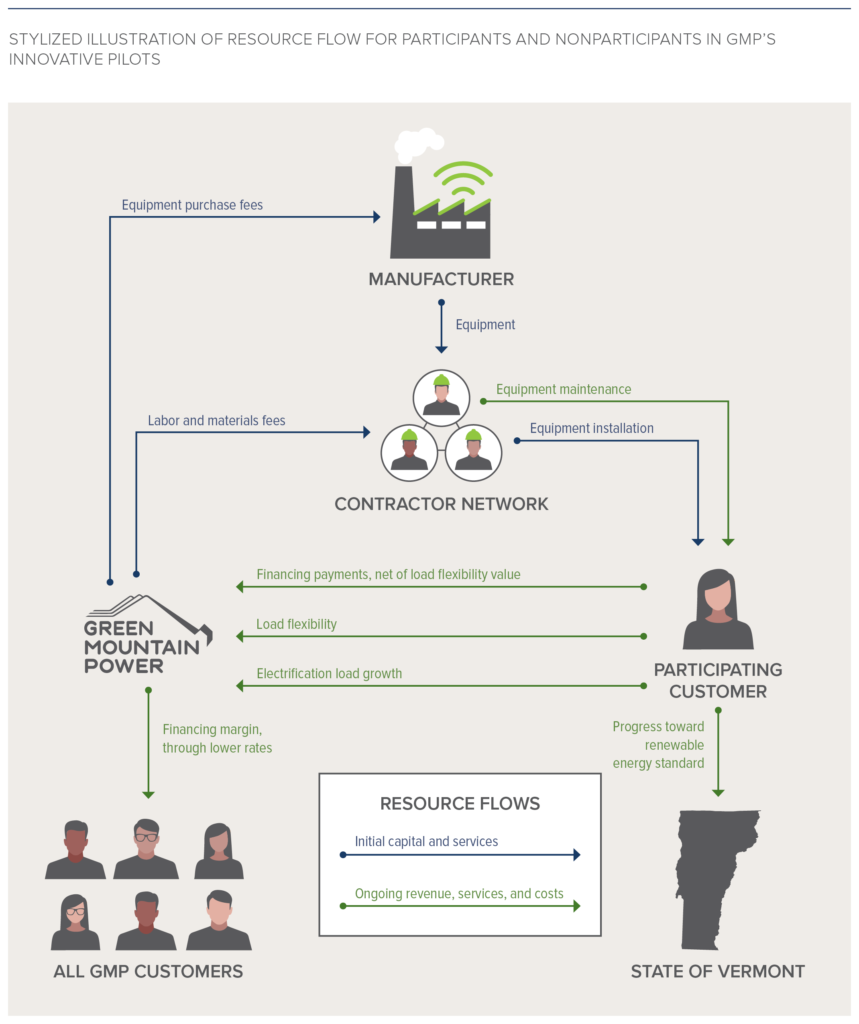
Customer-Centric Energy Transformation
How one Vermont utility is leading the charge
Download RMI’s new report, Customer-Centric Energy Transformation: A Case Study of the Opportunity with Green Mountain Power
The U.S. electricity industry needs new business models to complete the transformation to an affordable, reliable, low-carbon energy system. New models that transition away from traditional cost-of-service regulation can empower customers to take control of their energy use, make the system more efficient and resilient, and support investment in a modern grid.
Green Mountain Power (GMP), an investor-owned utility in Vermont, is leading the way with innovative customer offerings and business model transformation. It is the only utility named to Fast Company’s top 10 most innovative companies in energy. Beginning in early 2017, Rocky Mountain Institute worked with Green Mountain Power to assess how it can advance energy system transformation by building on the utility’s portfolio of innovative customer programs and evolving toward a new business model. Our new report, Customer-Centric Energy Transformation, presents our assessment of GMP’s imperative for transformation, a review of its progress so far, and recommendations for additional steps to expand the scope and reach of its customer programs.
GMP Innovation
GMP offers customers a suite of new products to meet their energy needs with new and efficient technologies. The eHome program offers a holistic home energy efficiency overhaul. Customers can install a Tesla Powerwall battery system for backup energy at reduced cost in return for enabling GMP to dispatch the battery to lower grid costs. Rural customers wishing to go off-grid can get GMP’s support to plan and manage their very own independent energy system. GMP offers free home electric-vehicle chargers and discounted off-peak charging. And customers can upgrade their space and water heating with efficient electric heat pumps while also enrolling these devices in demand response to support the grid. These offerings include on-bill financing to reduce or eliminate up-front costs to the customer.
By offering financing to individual customers, GMP is also pursuing a new business model that aims both to stabilize revenue in the face of declining energy sales and to ensure all customers benefit from the growth of distributed energy resources (DERs). The heat pump program provides an illustrative example. GMP procures the heat pumps, relies on local contractors for installation, and finances the equipment for participating customers. The up-front cost of the heat pumps is captured in GMP’s rate base alongside other utility investments. The financing payments from participants return to the broader customer base by offsetting a portion of GMP’s annual revenue requirement. These payments are structured to return a net benefit to nonparticipating customers. The heat pumps also typically replace fossil-fuel heating systems, generating new electricity sales while lowering carbon emissions. These new energy sales can help spread the fixed costs of the grid and keep bills affordable, particularly when the devices are managed to shift load to low-cost times of day.
Meeting Vermont’s Ambitious Goals
GMP and the state of Vermont have high aspirations for energy system transformation, and meeting them will require scaling up adoption of this suite of products and expanding the scope of current GMP customer offerings.
We estimate that to meet its goals, GMP will need to significantly ramp up most if not all of its customer programs over the next 10 years, in some cases by as much as ten- or twentyfold. In order to support this scaling, we identified four approaches GMP can take to build customer participation:
- Ramp up efforts to understand customer needs, segment those customers into groups, and use those insights to inform product development, sales, and marketing.
- Test high-saturation adoption opportunities that leverage tightly knit social networks, bulk purchase structures, and well-timed default customer offers.
- Design bundled offerings to curate choices based on typical customer needs and leverage integration of complementary technologies.
- Test alternative financing options like an on-bill tariff program to make offerings affordable for customers who want to own their own devices.
We found that GMP can expand the scope of its customer offerings by developing new programs to fill specific gaps and that could add significant value for customers and the energy system. This could include:
- Providing new bundled offerings to cohorts of small- and medium-business customers by business type, including a holistic energy concierge service to perform energy audits and advise customers on solutions.
- Encouraging electric vehicle (EV) adoption and flexible charging with an EV charging incentive program, including free home charging equipment and incentives to charge off-peak. GMP has acted on this recommendation, launching its home EV charging program in late 2017.
- Enrolling a wide range of devices, both residential and commercial, into an automated load flexibility program and optimizing these loads to support a more efficient, low-cost, reliable energy system. GMP would compensate customers for these benefits through credits on their bill.
- Updating rate offerings to provide distinct and attractive value propositions to customers, and communicating this value effectively, especially for those customers who may prefer not to enroll in central management of their devices.
Looking Beyond Vermont
At first glance, Vermont and GMP may appear unique, with ambitious energy transformation and clean energy goals and a unique culture. But in fact, the challenges of declining energy sales, disruptive DER technologies, and clean energy goals face many states and utilities across the country. Utilities beyond Vermont can test and adopt elements of GMP’s customer-centric strategy for driving the electricity system transformation. In particular, utilities facing declining load forecasts may find value in creating new electrification offerings to accelerate fuel switching and support lower carbon options for space heating, water heating, and mobility. Utilities can also structure new offerings that generate benefits for all customers, including nonparticipants, through demand flexibility and novel financing, and build toward a system where customers are empowered to lead the transformation to an affordable, reliable, low-carbon energy system.
